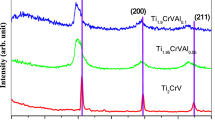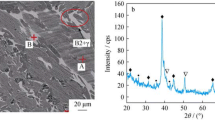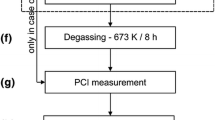Abstract
The bulk Ti–6Al–4V alloy was hydrogenated at the temperature range of 723–973 K, and the hydrogen absorption characteristics and hydrogen absorption kinetics were investigated. The results show that there are two types of hydrogen absorption characteristics at different temperatures. The hydrogen content decreases, and the time reaching reaction equilibrium is shorten with the isothermal hydrogenation temperature increasing. Meanwhile, the mechanism of the hydrogen absorption kinetics is different at different temperatures. The incubation period exists at the initial hydrogen absorption stage below 823 K, and Ka2 (the reaction rate constant of Stage 2) ≫ Ka1 (the reaction rate constant of Stage 1). And there is no incubation period over 823 K, Ka1 ≫ Ka2.
Similar content being viewed by others
Avoid common mistakes on your manuscript.
1 Introduction
Among Ti-based alloys, Ti–6Al–4V (TC4) alloy is the most popular α + β alloy, covering about 50% of total titanium production [1]. Its major applications are in aerospace, biomedical, and chemical industries because of low density, good corrosion resistance and excellent mechanical properties [2, 3]. The main problems of titanium alloys are low utilization rate and limited application which result from the low recycling ratio and high costs. Currently, the recycling methods of the titanium and alloys are cold hearth melting (CHM) and vacuum arc re-melting (VAR) in industry. However, the deficiencies of the methods are high cost and inhomogeneous composition [4]. Titanium has a strong affinity for hydrogen. The titanium hydrides formed after hydrogen absorption cause hydrogen embrittlement, which is easy to get titanium hydride powders through the ball-milling [5–8]. Hydrogen is also used as a temporary alloying element in titanium, and it can be charged into titanium and easily removed by vacuum annealing [9]. He et al. [10] and Sun et al. [11] investigate the effect of hydrogen on microstructural evolution and deformation behaviors of titanium alloys. And Ivasishin et al. [12] fabricate titanium alloys through powder metallurgy (PM) processes using the hydrogenated titanium powders as the raw materials, which has great economical potential and good mechanical properties.
It was reported that the titanium alloy scrap was recycled by hydrogenation–dehydrogenation and deoxidation process, obtaining the low oxygen content alloy powder and producing various Ti-based solid solution carbonitrides with good mechanical properties economically [4, 13]. Zhang et al. [14] studied the hydrogen absorption properties of Zr(V1−xFex)2 intermetallic compounds and concluded that the hydrogen diffusion in the hydride layer is a rate-controlling step, and the hydrogenation process can be divided into the rapid absorbing stage and the stable absorbing one. The hydrogen absorption characteristics of V4Cr4Ti alloy was investigated at the temperature range of 373–773 K by Kumar et al. [15]. The results show that the incubation exits at lower hydrogenation temperature ranges and disappears at higher temperature. As the most widely used titanium alloy, a large amount of TC4 alloy scrap are produced in the actual production. To improve industry TC4 alloy scrap recycling ratio and reduce production costs, the recycling of TC4 alloys scrap using hydrogenation and PM techniques gets more attention, and the Ti alloys fabricated by titanium hydride powders can improve densification, sintered density and obtain good mechanical properties. However, the hydrogenation behaviors on bulk TC4 alloy were rarely conducted. In this context, the hydrogenation behaviors of bulk TC4 alloy scrap were investigated under constant pressure at the temperature range of 723–973 K. Meanwhile, the dependence of hydrogen absorption kinetics on temperature was discussed in hydrogen absorption process.
2 Experimental
The raw material is bulk TC4 alloy, which was cut into 16 mm × 18 mm × 18 mm rectangles specimens. The specimens were polished and treated by HCl and NaOH.
The specimens were put in horizontal tube furnace at the predetermined temperatures of 723, 773, 823, 873, 923 and 973 K for isothermal hydrogenation under a hydrogen pressure of 3.0 MPa, respectively. In this work, the hydrogen absorption experiments were conducted in a constant volume system, and the hydrogen absorption capacity (w) of TC4 alloy was calculated according to the Ideal Gas Law by:
where p0 is the initial pressure of reactor and pt is the pressure at time t, V is the volume of reactor, m is the weight of TC4 alloy, R refers to the gas constant and T is the hydrogenation temperature.
The hydrogen absorption kinetics was evaluated using a pressure–composition–temperature (PCT) equipment with vacuum system. The reaction rate in this case can be expressed by the changing rate of hydrogen pressure due to the absorption (dP/dt):
where Ka is defined as the absorption rate constant and it is independent of hydrogen pressure (p) and pe is the hydrogen pressure at the final equilibrium state. Equation (2) is solved as follows and Ka could be measured by the slopes of straight lines of Eq. (3):
3 Results and discussion
3.1 Hydrogen absorption characteristics
According to Eq. (1), the hydrogen absorption curves of bulk TC4 alloy at different temperatures under a hydrogen pressure of 3.0 MPa are shown in Fig. 1. It is easy to see from Fig. 1 that there are two obvious types of the curves. The incubation period exists in the hydrogen absorption process below 823 K, but disappears over 823 K. The hydrogen content increases slowly at the beginning of hydrogen absorption, and subsequently increases quickly below 823 K. However, the hydrogen content increases rapidly when the specimens absorb initially hydrogen and then slows gradually up to the reaction equilibrium over 823 K.
The hydrogen content reaching the hydrogenation reaction equilibrium at different temperatures is shown in Fig. 2. According to Sivert’s law, the solubility of hydrogen (CH) in TC4 alloy is related to hydrogenation temperature (T) and the hydrogen partial pressure (p), which can be described as follow [16]:
where K is coefficient correlated with temperature (T) and solution energy (ΔE). K0 is a constant. Because ΔE is a negative value, the hydrogen content decreases with temperature increasing. But it is also correlated to the stabilization of hydrides. Titanium hydrides are unstable at higher temperature. The decomposition process of hydrides enhances and hinders the further hydrogen absorption. Therefore, the hydrogen content is almost invariant and close to saturation below 823 K and decreases obviously with temperature increasing over 823 K.
According to the hydrogen absorption curves in Fig. 1, the increment rate of hydrogen content (α) could be calculated as follows:
where ω0 is the initial weight of bulk TC4 alloy, ωt and ωeq are the weight of the alloy at time t and final equilibrium, respectively. The increment rate of hydrogen content (α) could be intuitively described in the reaction process, defined as dα/dt [17].
Figure 3 shows the increment rate of hydrogen content in bulk TC4 alloy at different isothermal hydrogenation temperatures. The temperature is an important factor which governs the absorption rate of the hydrogenation process. The hydrogen increment rate increases to the maximum value with time increasing and subsequently decreases until the reaction equilibrium below 823 K. It is found that there exists obviously the incubation period before the maximum value, and the incubation period becomes short with temperature increasing. When the temperature is over 823 K, the hydrogen increment rate is the maximum level at the beginning of hydrogenation process and decreases gradually until the hydrogenation equilibrium with time increasing. It is suggested that the hydrogen increment rate and hydrogen absorption kinetics mechanism vary with temperatures in the bulk TC4 alloy. And the time of hydrogen absorbing becomes shorter with temperature increasing, but the trend is unobvious when temperature is over 823 K.
3.2 Hydrogen absorption kinetics
The hydrogen absorption reaction mechanism of the bulk TC4 alloy was conducted by comparing the observed absorption rates with the help of Hirooka’s kinetic theory [18]. The plots of ln[(pt − pe)/(p0 − pe)] versus hydrogenation time of bulk TC4 alloy are shown in Figs. 4, 5 at different hydrogenation temperatures.
The hydrogenation process of titanium or titanium alloys are composed of the primary three stages [19–21]: (1) hydrogen dissociation process on the surface of the alloy, which can be divided into physisorption, chemisorption and surface penetration process; (2) hydrogen atoms diffusion process, which includes diffusing through grain and phase boundaries; (3) hydride generation process, including nucleation and growth process.
As shown in Fig. 4, there are obvious inflections in the curves, and the slope becomes steep markedly after the inflection point. Therefore, the hydrogenation process of the bulk alloy can be divided into the slow absorbing stage (Stage 1) and the stable absorbing one (Stage 2). The corresponding slopes of the absorbing stages are designed as Ka1 and Ka2, namely the reaction rate constant, as listed in Table 1. The relationship between the reaction rate constants is Ka2 ≫ Ka1, indicating that the incubation period exists at Stage 1, which is consistent with the results in Fig. 3. Few hydrogen molecules decompose on the surface of the alloy at the beginning of hydrogenation below 823 K due to the low surface activity and slow chemisorption rate in the initial hydrogen absorption process at low temperature [17]. The time of incubation stage at 723, 773 and 823 K are 140, 70 and 30 min, respectively. The temperature has obvious influence on the incubation stage. And the higher the temperature is, the shorter the incubation stage is [22]. While the hydrogen absorption kinetics cannot be described by a rate-limiting step, it can obtain a valuable insight from a hydrogenation model involving one surface barrier and diffusion barrier [20]. After the inflection point, the hydrogenation becomes stable and the reaction rate (Ka2) increases with temperature increasing in Stage 2. The hydrogen concentration is locally enhanced on the surface, and the increase of hydrogen content induces the micro cracks growth. Then, the fresh surfaces are formed in the alloy matrix, which improves the hydrogen diffusion rate from the surface to the internal and promotes the formation of hydride. The volume change in phase transformation process leads to a lot of micro cracks [23, 24]. Therefore, the reaction rate increases rapidly compared with that in Stage 1.
The hydrogen absorption kinetic curves also have inflection points, as shown in Fig. 5, including the rapid absorbing stage (Stage 1) and the stable absorbing stage (Stage 2) over 823 K. The different slopes before and after the inflection point are designed as Ka1 and Ka2 (Table 1). The reaction rate shows the maximum level at the beginning of hydrogenation process and decreases at the stable reaction stage. It is found that the incubation period disappears over 823 K at Stage 1, which results from the higher surface activity, diffusion rate, nucleation rate and the disappearance of TiO2 on the surface above 873 K [25]. Owing to the solid solution of oxygen in TC4 alloy matrix at high temperature, the TiO2 film on the surface disappears [26]. However, the reaction rate decreases obviously in Stage 2 compared with that in Stage 1. It is well known that the hydrogen absorption reaction of the titanium is an opposing reaction, which is described as follow [27]:
where Q is the heat energy of hydride formation. The hydrogen absorption and desorption are two parallel process. Therefore, the decomposition process of titanium hydride cannot be neglected at higher temperature. The reaction is difficult to go toward the right with temperature increasing due to the exothermic reaction in the hydrogen absorption process. That is to say, the hydride TiHx becomes unstable, and the desorption process promotes gradually at high temperature. The temperature (over 873 K) meets the requirements of the hydrogen release of the Ti alloys.
The hydrogen absorption reaction in bulk TC4 alloy reveals that the hydrogen absorption rate and hydrogen absorption kinetics mechanism vary with temperatures, which is easy to be distinguished by comparing Figs. 4 with 5. The reaction has the incubation stage occurred at initial hydrogenation process below 823 K, which results mainly form the physisorption, chemisorption and surface penetration of the hydrogen. But there is no incubation period above 823 K because the hydrogen atom diffusion is the dominated process at higher temperature.
4 Conclusion
In this study, the hydrogenation behaviors of TC4 alloy are obviously different at different temperatures. There exists incubation period below 823 K, and the incubation period disappears above 823 K. The hydrogen dissociation process on the surface of the alloy at different temperatures results in the differences of hydrogen absorption characteristics. The hydrogen content of TC4 alloy has close relation to the isothermal hydrogenation temperature, and it decreases with the temperature increasing.
References
Su YQ, Wang L, Luo LS, Liu XW, Guo JJ. Investigation of melt hydrogenation on the microstructure and deformation behavior of Ti–6Al–4V alloy. Int J Hydrog Energy. 2011;36(1):1027.
Yu CY, Shen CC, Perng TP. Microstructure of Ti–6Al–4V processed by hydrogenation. Scripta Mater. 2006;55(11):1023.
Sahoo R, Jha BB, Sahoo TK. Effect of primary alpha phase variation on mechanical behaviour of Ti–6Al–4V alloy. Mater Sci Technol. 2015;31(12):1486.
Oh JM, Roh KM, Lee BK, Suh CY, Kim W, Kwon HJ, Lim JW. Preparation of low oxygen content alloy powder from Ti binary alloy scrap by hydrogenation–dehydrogenation and deoxidation process. J Alloys Compd. 2014;593(4):61.
Qazi JI, Senkov ON, Rahim J, Froes FH. Kinetics of martensite decomposition in Ti–6Al–4V–xH alloys. Mater Sci Eng A. 2003;359(1):137.
Shan DB, Zong YY, Lu TF, Lv Y. Microstructural evolution and formation mechanism of FCC titanium hydride in Ti–6Al–4V–xH alloys. J Alloys Compd. 2007;427(1):229.
Senkov ON, Froes EH. Thermohydrogen processing of titanium alloys. Int J Hydrog Energy. 1999;24(6):565.
Tal-Gutelmacher E, Eliezer ED. Hydrogen cracking in titanium-based alloys. J Alloys Compd. 2005;404:621.
Froes FH, Senkov ON, Qazi JI. Hydrogen as a temporary alloying element in titanium alloys: thermohydrogen processing. Int Mater Rev. 2004;49(3–4):227.
He WJ, Zhang SH, Song HW, Cheng M. Hydrogen-induced hardening and softening of a β-titanium alloy. Scripta Mater. 2009;61(1):16.
Sun ZG, Hou HL, Zhou WL, Wang YQ, Li ZQ. The effect of hydrogen on microstructures evolution and deformation behaviors of Ti–6Al–4V alloys. J Alloys Compd. 2009;476(1):550.
Ivasishin OM, Anokhin VM, Demidik AN, Savvakin DG. Cost-effective blended elemental powder metallurgy of titanium alloys for transportation application. Key Eng Mater. 2000;188:55.
Jung SA, Kwon HJ, Roh KM, Suh CY, Kim W. Ti-based solid solution carbonitrides prepared from Ti-alloy scraps via a hydrogenation-dehydrogenation process and high-energy milling. Met Mater Int. 2015;21(5):923.
Zhang TB, Wang XF, Hu R, Li JS, Yang XW, Xue XY, Fu HZ. Hydrogen absorption properties of Zr(V1−xFex)2 intermetallic compounds. Int J Hydrog Energy. 2012;37(3):2328.
Kumar S, Taxak M, Krishnamurthy N. Hydrogen absorption kinetics of V4Cr4Ti alloy prepared by aluminothermy. Int J Hydrog Energy. 2012;37(4):3283.
Zhang Y, Zhang SQ. Hydrogenation characteristics of Ti–6Al–4V cast alloy and its microstructural modification by hydrogen treatment. Int J Hydrog Energy. 1997;22(2):161.
Guo Q, Hou H, Ren X. Hydrogen absorption kinetics of porous Ti6Al4V alloys. J Alloys Compd. 2009;486(1):754.
Hirooka Y, Miyake M, Sano T. A study of hydrogen absorption and desorption by titanium. J Nucl Mater. 1981;96(3):227.
Grabke HJ, Horz G. Kinetics and mechanisms of gas-metal interactions. Annu Rev Mater Sci. 1977;7:155.
Martin M, Gommel C, Borkhart C, Fromm E. Absorption and desorption kinetics of hydrogen storage alloys. J Alloys Compd. 1996;238(1):193.
Borgschulte A, Gremaud R, Griessen R. Interplay of diffusion and dissociation mechanisms during hydrogen absorption in metals. Phys Rev B. 2009;78:9.
Lin HC, Lin KM, Sung CW, Wu KC. Characterizations of activation and anti-poisoning in an LmNi4.8Al0.2 hydrogen storage alloy. Int J Hydrog Energy. 2007;32(13):2494.
Clarke CF, Hardie D, Ikeda BM. Hydrogen-induced cracking of commercial purity titanium. Corros Sci. 1997;39(9):1545.
Lee SM, Perng TP. Microstructural correlations with the hydrogenation kinetics of FeTi1+ξ alloys. J Alloys Compd. 1991;177(6):107.
Mintz MH, Bloch J. Evaluation of the kinetics and mechanisms of hybriding reactions. Prog Solid State Chem. 1985;16(3):163.
Jiménez C, Moreno FG, Pfretzschner B, Klaus M. Decomposition of TiH2 studied in situ by synchrotron X-ray and neutron diffraction. Acta Mater. 2011;59(16):6318.
Li MQ, Zhang WF, Zhu TK, Hou HL, Li ZQ. Effect of hydrogen on microstructure of Ti–6Al–4V alloys. Rare Metal Mat Eng. 2010;39(1):1.
Acknowledgements
This work was financially supported by Sichuan Province Science and Technology Project (No. 2013VTZC04).
Author information
Authors and Affiliations
Corresponding author
Rights and permissions
About this article
Cite this article
Pan, L., Wang, CM., Xiao, SF. et al. Hydrogenation behaviors and characteristics of bulk Ti–6Al–4V alloy at different isothermal temperatures. Rare Met. 38, 1131–1135 (2019). https://doi.org/10.1007/s12598-016-0852-y
Received:
Revised:
Accepted:
Published:
Issue Date:
DOI: https://doi.org/10.1007/s12598-016-0852-y









